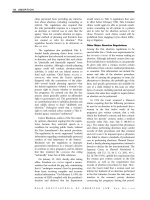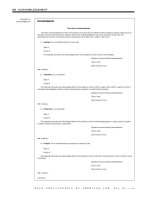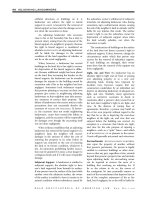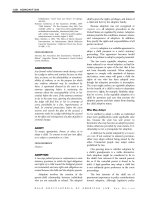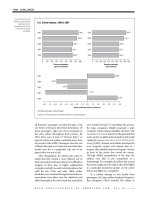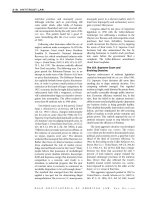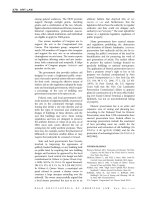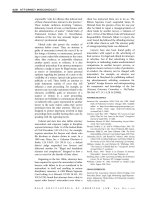Gale Encyclopedia Of American Law 3Rd Edition Volume 4 P40 pot
Bạn đang xem bản rút gọn của tài liệu. Xem và tải ngay bản đầy đủ của tài liệu tại đây (172.16 KB, 10 trang )
The FMC promulgates rules and regulations
to interpret, enforce, and ensure compliance
with shipping and related statutes by common
carriers and other persons subject to those
statutes.
The staff of the FMC administers programs
to ensure compliance with the provisions of the
shipping statutes. These programs include the
submission of information, and field investiga-
tions and audits of activities and practices of
common carriers, terminal operators, and
others subject to the shipping statutes. The
FMC also conducts rate analyses, studies, and
economic reviews of current and future trade
conditions, including the extent and nature of
competition in various trade areas.
The FMC conducts investigations of prac-
tices by foreign governments and foreign
carriers that adversely affect the U.S. shipping
trade. The commission works with the
DEPART-
MENT OF STATE
to eliminate discriminatory
practices on the part of foreign governments
against U.S flag shipping and to promote
fairness between the United States and its
trading par tners.
The FMC has sought to become more
efficient by implementing an electronic filing
system. By 2002 it was able to issue service on
companies electronically, which proved crucial
during the fall of 2001, when the anthrax crisis
prevented the delivery of mail by the
U.S. POSTAL
SERVICE
in some areas. In addition, it now posts
filings of important public proceedings on its
web site.
FURTHER READINGS
Federal Maritime Commission. 2003. Annual Program
Performance Report. Available online at http://www.
fmc.gov (accessed July 23, 2009).
“Federal Maritime Commission News.” 2004–2009. U.S.
Politics Today. Available online at http://uspolitics.
einnews.com/news/fmc; website home page: http://
uspolitics.einnews.com (accessed September 2, 2009).
U.S. Government Manual Website. Available online at http://
www.gpoaccess.gov/gmanual/index (accessed July 21,
2009).
FEDERAL MEDIATION
AND CONCILIATION SERVICE
The Federal Mediation and Conciliation Service
(FMCS) is an independent agency of the U.S.
government that seeks to prevent or settle
disputes between labor unions and management
that affect interstate commerce. The FMCS
was established by the 1947
LABOR-MANAGEMENT
RELATIONS ACT
(61 Stat. 153 [29 U.S.C.A.
§ 172]), better known as the TAFT-HARTLEY ACT.
Mediators for the FMCS have no law enforce-
ment authority and must rely on their own
persuasive techniques. The FMCS has its
headquarters in Washington, D.C., and sup-
ports 68 field offices.
The Labor-Management Relations Act
requires that parties to a labor contract must
file a notice with the Federal
MEDIATION and
Conciliation Service (FMCS) if agreement is not
reached within 30 days before a contract
termination or reopening date. The FMCS is
required by the act to avoid mediation of
disputes that would have only a minor effect on
interstate commerce. However, in seeking to
promote labor peace through the encourage-
ment and development of long-term, stable
relationships between labor and management,
the FMCS has taken a broad view of its statutory
mandate and has involved itself in disputes that
have little effect on interstate commerce.
The FMCS provides both mediation and
conciliation services. Most of its interventions
involve mediation, which is a voluntary, non-
binding form of dispute resolution. A mediator
attempts to facilitate an agreement by conduct-
ing meetings and coordinating discussions. A
mediator may make substantive suggestions as
an active participant to help the parties reach a
voluntary agreement.
FMCS mediators must be neutral and must
have a minimum of seven years’ experience in
bargaining methods and tactics. Mediators must
maintain strict confidentiality regarding the
positions of both sides and may be removed for
bias or a failure to maintain confidences. The
FMCS employs more than 200 mediators, who
typically handle about 30,000 cases every year.
Conciliation is a different form of dispute
resolution. A conciliator acts as a neutral
THIRD
PARTY
, serving as a resource person for both
sides. Generally, a conciliator will not partici-
pate in any joint meetings between the parties.
Instead, a conciliator will present each party’s
position to the other in separate sessions. The
conciliator may also suggest solutions, especially
when negotiations have reached a stalemate.
The FMCS will also provide
ARBITRATION
support. Arbitration is an informal method of
adjudication, in which both parties present their
side of the case, and an arbitrator decides who
will prevail. Upon the joint request of a union
FEDERAL MEDIATION AND CONCILIATION SERVICE 379
GALE ENCYCLOPEDIA OF AMERICAN LAW, 3RD E DITION
FEDERAL MEDIATION AND CONCILIATION SERVICE 379
and an employer, the FMCS will help to select
arbitrators from a roster of private citizens.
The agency also employs preventive media-
tion techniqu es once an agreement is reached.
These techniques include the organization of or
participation in labor-management committees,
which serve as outlets for discussing problems
and the training of labor and management in
ALTERNATIVE DISPUTE RESOLUTION techniques. This
training is often presented through conferences
and seminars.
The FMCS developed web technology that
provides the public with comprehensive infor-
mation. More importantly, FMCS has shifted
much of the work done by mediators from
paper to electronic documents, which are
accessible through its web site. By 2009 FMCS
had in place conference centers linked to the
INTERNET, along with other technology, that
provide online mediation.
FURTHER READINGS
Federal Mediation and Conciliation Service. Available online
at www.fmcs.gov (accessed September 23, 2009).
Newman, William A. 1990. “Use of Non-Adjudicative
Third-Party Dispute Resolution Methods by Dispute
Resolution Agencies of the United States Government.”
Ohio Northern University Law Review 17.
U.S. Government Manual Website. Available online at www.
gpoaccess.gov/gmanual (accessed November 10, 1993).
FEDERAL NATIONAL MORTGAGE
ASSOCIATION
The Federal National Mortgage Association
(known colloquially as “Fannie Mae”)isthe
largest U.S. corporation. The federally chartered
Fannie Mae holds a unique place in the national
mortgage market. Established by federal law in
1934, it was originally a
NEW DEAL program.
Since the 1970s it has been a privately owned,
for-profit corporation that is regulated and
overseen by the federal government. Its chief
purpose is to buy federally guaranteed home
mortgages on the secondary market, thus
freeing lending institutions to make more funds
available for new mortgages for low- to middle-
income home buyers. Tighter federal regulation
began in the early 1990s, even as critics in
Washington, D.C., argued that Fannie Mae
should be completely privatized.
A broad federal response to the Great
Depression gave rise to Fannie Mae. In the
1930s the national housing market was devas-
tated when a tight supply of money, coupled
with a failure of banks, made mortgage financ-
ing extremely difficult to secure. Congress
responded first in 1934 by creating the Federal
Housing Administration (FHA), a body charged
with stabilizing the mortgage market by insur-
ing home loans (National Housing Act of 1934,
subch. II [12 U.S.C.A. §§ 1707–1715z-11
(1980)]). This measure was not enough to
salvage the mortgage market, however. In 1935
lawmakers created the Reconstruction Finance
Corporation (15 U.S.C.A. § 601 [1983], repealed
by Reorganization Plan of 1957 No. 1 [5 U.S.C.
A. § 903 note (1977)]), and in 1938, they added
a subsidiary, Fannie Mae (Federal National
Mortgage Association Charter Act [12 U.S.C.A.
§§ 1716–1723h (1980)]). Fannie Mae’s federal
charter required it to buy FHA-insured loans
from mortgage lenders, thus increasing the
supply of mortgage funds available for lending.
Fannie Mae played a major role in the post–
World War II boom years in housing. Its
portfolio grew after it was authorized to
purchase Veterans Administration (VA) loans
in addition to FHA loans, a measure that fueled
an enormous expansion of housing in the late
1940s and 1950s. In 1954 the federal govern-
ment began issuing stock in Fannie Mae as part
of a plan to share responsibility for the
corporation’s financial health with lending
institutions. It issued
PREFERRED STOCK to the
TREASURY DEPARTMENT and nonvoting COMMON
STOCK
to mortgage lenders. For the latter,
purchase of stock became a prerequisite for
selling mortgages to Fannie Mae.
A shift to private ownership began in 1968.
First, Congress split Fannie Mae into two
entities: One retained the name Fannie Mae,
and the other was called the
GOVERNMENT
NATIONAL MORTGAGE ASSOCIATION
(GNMA), under
authority of title III of the National Housing Act
(12 U.S.C.A. §§ 1716–1716b [1983]). Whereas
GNMA, also known as “Ginnie Mae,” was
chartered to provide funding for federally
assisted housing programs, the new Fannie
Mae retained its original mission but with a
new source of funding: Lawmakers wanted it to
become self-sustaining through fees and securi-
ties. In 1970 the federal government sold its
share of stock to Fannie Mae for $216 million,
severing its last financial tie to the corporation.
Two years later, Fannie Mae expanded the scope
of its investments by purchasing non-federally
guaranteed loans as well.
GALE ENCYCLOPEDIA OF AMERICAN LAW, 3RD E DITION
380 FEDERAL NATIONAL MORTGAGE ASSOCIATION
Despite its financial independence, the
corporation remains closely linked by its charter
to the federal government. Federal oversight
remained, as did Fannie Mae’s mission to
provide services to low-, moderate-, and
middle-income homebuyers. During the 1970s
and 1980s, the corporation grew enorm ously,
particularly through the securities market,
where it sold so-called mortgage-backed securi-
ties, which are pools of mortgage loans acquired
from lenders for which the acquiring corpora-
tion earns guarantee fees. Its stock was actively
sought, primarily because of profitability and a
sense on Wall Street that the federal govern-
ment would always back up the corporation in
bad times. In fact, the enormous flo w of money
through Fannie Mae rivaled that of the nation’s
major lending institutions. Fannie Mae volun-
tarily registered its common stock with the
SECURITIES AND EXCHANGE COMMISSION (SEC) in
2003, thus requiring it to file periodic financial
disclosures with the SEC under the Securities
Exchange Act of 1934.
Calls for reform of Fannie Mae began in the
1980s. The anti-regulatory administration of
President
RONALD REAGAN suggested privatizing it
completely. But action only followed a scandal
of the savings and loan industry, in which greed
and mismanagement plunged many of the
nation’s thrifts into insolvency—at a cost to
taxpayers of hundreds of billions of dollars.
Motivated to protect the federal government
from suffering such losses again, Congress in
1992 passed the Federal Housing Financial
Enterprises Safety and Soundness Act (Pub. L.
No. 102-550, § 1301, 12 U.S.C.A. § 4501). The
law tightened regulations governing Fannie Mae
and related federally chartered financial institu-
tions. Specifically, it requires these institutions
to pass periodic review to ensure that they
maintain adequate capital according to risk
criteria determined by Congress. This oversight
is conducted by the Office of Federal Housing
Enterprise, a part of the
DEPARTMENT OF HOUSING
AND URBAN DEVELOPMENT
. Under law, such a
corporation must submit a plan to restore its
capital levels if it fails review. Significant
undercapitalization can lead to the appointment
of a conservator to run the cor poration.
Congress also prohibited excessive executive
and staff salaries. At the same time, it gave
Fannie Mae additional responsibility for helping
low-income home buyers.
Major trouble hit the corporation in the
mid-2000s, when significant accounting pro-
blems put both Fannie Mae and Freddie Mac in
the spotlight and at risk. In July 2008, President
GEORGE W. BUSH announced his plan to rescue
Fannie Mae and Freddie Mac, in an attempt to
stop or stay the sliding sub-prime mortgage
crisis and its effect on the nation’s overall
economy. The plan called for Congress to
authorize up to 18 months’s funds (billions of
dollars) to help the companies through a critical
period. This would be done by government
investments, e.g., government-purchased com-
pany stocks and loans. Opposition from both
parties in Congress was initially substantial.
But the reality of the companies’s role in the
national economy was indisputable. Together,
Fannie Mae and Freddie Mac either held or
guaranteed mortgages valued at more than $5
trillion dollars, and both companies were rapidly
sinking into debt from defaulted mortgage loans.
As of July 2008, Fannie Mae carried debt of $800
million, while Freddie Mac had about $740
million in debt. According to the Mortgage
Bankers Association, nearlyfour percentof prime
mortgages were past due or in
FORECLOSURE as of
September 2007, the highest rate since the group
started tracking prime and sub-prime mortgages
separately in 1998. The default rate for sub-prime
loans was almost one in four, or 24 percent. The
combined rate of delinquency and foreclosure
was 7.3 percent, higher than at any time since
the group started tracking data in 1979. Accord-
ing to the IMF in its April 2008 Global Financial
Stability Report, global losses could reach $945
billion once other related losses, such as in
commercial real estate, were included.
In September 2008 the Treasury Secretary
announced the government takeover (conserva-
torship) of Fannie Mae and Freddie Mac, in the
form of government-owned (taxpayer-funded)
and controlled stock, representing an extraordi-
nary move by the government of the world’smost
eminent free enterprise nation. The news of
government intervention in private enterprise
made front-page headlines around the world. In
the next few days, a modest surge in the
STOCK
MARKET
signaled hope, but the nation’smortgage
foreclosures had not yet peaked in the midst of
the now-global financial meltdown.
By August 2009 Fannie Mae needed an
additional $10.7 billion, as the value of non-
performing loans continued to burden it. At
GALE ENCYCLOPEDIA OF AMERICAN LAW, 3RD E DITION
FEDERAL NATIONAL MORTGAGE ASSOCIATION 381
that time, it had used up approximately $45
billion of the $200 billion reserve slated to keep
it afloat. However, financial indicators pointed
toward a leveling-off of losses as there appeared
to be a slowdown in the increase of estimated
loan defaults, and the nation’s economy
appeared heading toward slow recovery.
FURTHER READINGS
Bajaj, Vikas and Louise Story. “Mortgage Crisis Spreads Past
Subprime Loans.” The New York Times, 12 February
2008.
CNN News. 2009.“Fannie Mae Needs Another $10.7B in
Federal Aid.” August 6, 2009. Available online at http://
money.cnn.com/2009/08/06/news/companies/Fannie_-
Mae_earnings/“>; website home page: .
com/ (accessed September 20, 2009)
Dodd, Randall and Paul Miller. “Outbreak: U.S> Subprime
Contagion.” Finance & Development, Vol. 45, No.2,
June 2008.
Fannie Mae Website Homepage and various links. 2009.
Available online at ; website
home page: (accessed Sep-
tember 20, 2009)
“Federal National Mortgage Association (Fannie Mae)” The
New York Times, September 24, 2008.
Froomkin, A. Michael. 1995. “Reinventing the Government
Corporation.” University of Illinois Law Review.
Labaton, Stephen. “Bush Offers Plan to Save Fannie Mae,
Freddie Mac.” The New York Times, 14 July 2008.
Malloy, Robin Paul. 1986. “The Secondary Mortgage
Market: A Catalyst for Change in Real Estate.” Southern
Methodist University Law Review (February).
CROSS REFERENCE
Housing and Urban Development Department.
FEDERAL PROCEDURE
See CIVIL PROCEDURE.
FEDERAL QUESTION
An issue directly involving the U.S. Constitution,
federal statutes, or treaties between the United
States and a foreign country.
Application of these kinds of law to
particular cases or interpretation of the mean-
ings of these laws is a power within the
authority of the federal courts. The authority
to hear lawsuits that turn on a point of federal
law is called federal question jurisdiction. Under
28 U.S.C.A. § 1331 (1993), U.S. district courts
“shall have
ORIGINAL JURISDICTION of all civil
actions arising under the Constitution, laws, or
treaties of the United States.” Unlike federal
jurisdiction based upon
DIVERSITY OF CITIZENSHIP
under 28 U.S.C.A. § 1332 (Supp. 2003), federal
question jurisdiction is not dependent on the
parties meeting a prescribed
AMOUNT IN CONTRO-
VERSY
.
CROSS REFERENCES
Jurisdiction; Treaty.
FEDERAL REGISTER
A daily publication that makes available to the
public the rules, regulations, and other legal
notices issued by federal administrative agencies.
Executive Orders and agency regulations
were promulgated at a furious pace in the early
days of the
NEW DEAL under President FRANKLIN
D
. ROOSEVELT, but there was no requirement that
these regulations be centrally filed or regularly
published. It became increasingly difficult to
know which rules were in effect at any one time.
Two important cases were pursued all the way
to the U.S. Supreme Court before it was
discovered that the administrative regulations
that the defendants were accused of violating
were no longer in effect. Newspapers all over
the country castigated the government for
prosecuting people under nonexistent laws.
The furor led to enactment in 1935 of the
Federal Register Act, now part of 44 U.S.C.A.
§ 1501 et seq., a law that established the Federal
Register as a daily gazette for the government.
Orders from federal agencies or the
EXECUTIVE
BRANCH
do not become effective until they have
been published in the Federal Register. In 1937
the act was amended to create the
CODE OF
FEDERAL REGULATIONS
, a set of paperback books
that arrange effe ctive regulations from the
Federal Register by subject.
The Federal Register includes (1) presidential
proclamations and executive orders; (2) other
documents that the president from time to time
determines to have general applicability and legal
effect; (3) documents that are required by an act
of Congress to be published; and (4) other
documents selected for publication by the
director of the Federal Register. Documents are
placed on filefor public inspection at the Office of
the Federal Register in Washington, D.C., on the
day before they are published, unless an earlier
filing is requested by the agency issuing them.
The Federal Register has been published
continuouslysinceMarch14, 1936,anditprovides
the only complete history of the regulations of the
federal government with the text of all changes.
Regulations are published in the order in which
they are filed, but specific documents can be
GALE ENCYCLOPEDIA OF AMERICAN LAW, 3RD E DITION
382 FEDERAL PROCEDURE
located by consulting a table of contents in each
daily issueor in the monthly index. Separate guides
are prepared, to note which regulations have been
changed in an issue (“List of C.F.R. Parts Affected
in This Issue”) and the regulations changed at any
time since the beginning of the month (“Cumula-
tive List of C.F.R. Parts Affected During April,” for
example). A separate pamphlet is published along
with the monthly index that lists references to all
the changes in regulations since the last time the
affected title of the Code of Federal Regulations
was revised. All references are made to the Code of
Federal Regulations because it is the topically
organized version of the regulations that are
published daily in the Federal Register.
The text of any document in the Federal
Register can be shown as good and sufficient
evidence that the document was properly filed
and that it is, therefore, good law. If a regulation
has not been published in the Federal Register, a
governmental agency would have to show that
an individual actually knew about it before it
could prosecute the person for violating it. This
encourages the agencies to be sure that their
regulations are published in the one place where
everyone can expect to find them.
As of July 31, 2003, the database for Federal
Register for each year subsequent to 1995, (and
subsequent to Volumes 60), was available and
searchable online at />fr/index.html. Documents may be retrieved in
ASCII format (full text, graphics omitted),
Adobe Portable Document Format, “PDF” (full
text with graphics), and “SUMMARY” format
(abbreviated text). The 1994 Federal Register
(Volume 59) database was also available but did
not have the same search capabilities, as it
contains no fields or section identifiers. It is also
possible to browse the current issue of the
Federal Register at the same site. Also accessible
is an online History of Line Item Veto Notices
(as published in the Federal Register) prior to
U.S. Supreme
COURT OPINION No. 97-1374
(argued April 27, 1998—decided June 25, 1998.
FEDERAL REGULATION
See ADMINISTRATIVE AGENCY; REGULATION.
FEDERAL REPORTER
®
A legal reference source primarily covering
published decisions of federal appellate courts.
The decisions are published in paperback
Federal Reporter pamphlets (advance sheets)
shortly after they are handed down and then
are issued in a hardbound volume when enough
cases have accumulated to fill a book. The
hardbound volumes are consecutively num-
bered as they are published. After 300 volumes
had been issued, a second series was started in
1924. Following the release of 999 volumes
in the second series, the third series started in
1993.
A case may be found in the Federal Reporter
in the volume whose number is that given first
in the citation for the case. If the case was
decided after 1924, the citation will refer to the
second series of the Federal Reporter. For
example, the case of O’Connor v. Lee-Hy Paving
Co., decided by the U.S. Court of Appeals for
the Second Circuit in 1978, is cited as 579 F.2d
194. It can be located on page 194 of volume
579 in the Federal Reporter, second series.
The Federal Reporter covers decisions by (1)
the
CIRCUIT COURT of appeals, the district courts,
the former U.S. Court of Customs and Patent
Appeals, the former U.S.
COURT OF CLAIMS, and
the Court of Appeals of the District of
Columbia for the years from 1880 to 1932; (2)
the
U.S. COURTS OF APPEALS and the former U.S.
Court of Customs and Patent Appeals for the
years beginning with 1932; (3) the U.S.
Emergency Court of Appeals from 1942 to
1961 and the U.S.
TEMPORARY EMERGENCY COURT
OF APPEALS
from 1972 to the present; and (4) the
former U.S. Court of Claims from 1960 to the
fall of 1982; thereafter it became the U.S. Claims
Court.
CD-ROM format is available. Other federal
court opinions are published in a series called
the
FEDERAL SUPPLEMENT.
CROSS REFERENCE
Reporter.
FEDERAL RESERVE BOARD
The Federal Reserve System, established by the
Federal Reserve Act (12 U.S.C.A. § 221), is the
central
BANK OF THE UNITED STATES. The Federal
Reserve is charged with making and adminis-
tering policy for the nation’s credit and
monetary affairs and helps to maintain the
banking industry in sound condition.
GALE ENCYCLOPEDIA OF AMERICAN LAW, 3RD E DITION
FEDERAL RESERVE BOARD 383
The Federal Reserve Board of Governors, or
Federal Reserve Board, has broad supervisory
powers over the functions of the Federal Reserve
System. It determines general monetary, credit,
and operating policies for the Federal Reserve
System and formulates the rules and regulations
that are necessary to carry out the purposes of the
Federal Reserve Act. A primary function of the
board is to influence credit conditions, such as
interest rates, in the nation’s marketplace. The
board regulates the amount of credit that may be
initially extended and subsequently maintained
on any securities, in order to prevent an excessive
use of credit for their purchase or carrying.
The Federal Reserve Board office is located
in Washington, D.C. The board is composed of
seven me mbers, appointed by the president of
the United States with the
ADVICE AND CONSENT
of the Sena te. The chair of the board must be
chosen from among the seven governors and
serves a four-year renewable term. Other board
members serve one nonrenewable 14-year term,
with one governor’s term expiring every other
January. By
EXECUTIVE ORDER, the chair of the
board is also a member of the National Advisory
Council on International Monetary and Finan-
cial Policies.
Following the passage of the Federal Reserve
Act, Congress attempted to claim exclusive
control over the management of monetary
policy. It asserted that this was the proper
function of Congress, as the constitutionally
The Fed and the 2008 Recession
A
recession is a period of economic
decline that is marked by wide-
spread unemployment, a fall in econom-
ic output, and the decline in value of
stocks and other financial instruments.
The Federal Reserve (often referred to as
the Fed)is charged with maintaining the
stability of the U.S. economy and has
several tools it can employ to improve
the business climate. These tools were
put to the test when the U.S. economy
went into recession in 2008. Though the
collapse of September 2008 was dramat-
ic, with Wall Street suffering dramatic
losses, economists believe the recession
started as early as April 2008. Federal
Reserve chairman Ben Bernanke moved
swiftly in the fall of 2008 to stabilize the
economy and then began working to
grow it. Despite these efforts, Bernanke
drew criticism for bailing out banks
while average Americans lost their homes
and jobs.
The Federal Reserve has three means
of dealing with a financial crisis by
managing the U.S. money supply. First,
it can lower the discount rate or interest
rate it charges to major banks that
borrow money from it on a short term
basis. Second, it can lower the reserve
requirements of banks; banks must have
on hand a certain percentage of the
deposits from customers. Third, it can
raise the amount of money in the
economy through its open market opera-
tions. This is done by the Fed repurchas-
ing government securities such as Trea-
sury bills from investors.
The U.S. housing market, which
had fueled much of the economic
expansion of the 2000s, began to lose
momentum in 2007. The Fed
began cutting interest rates in the fall
of 2007, in hopes of loosening a tighten-
ing credit market and as a way to
stimulate economic growth. The rate
eventually dropped to zero, yet this was
not enough to prevent a recession. In
November 2008 the Fed began to use
other ways of injecting money into the
system. It used methods called “quanti-
tative easing.” Bernanke had initially
opposed these methods but gave way
once the discount rate was at rock
bottom. These methods included buying
large amounts of longer-term Treasury
bonds and mortgage-backed securities
issued by government-sponsored com-
panies such as Fannie Mae and Freddie
Mac. It also purchased commercial debt
issued by private companies and con-
sumer lenders.
The recession was deepened by the
collapse of the investment banking firm
Lehman Brothers, Washington Mutual
Bank, and the near collapse of the insurer
American International Group (AIG). In
early October 2008, Congress passed the
Emergency Economic Stabilization Act
of 2008. Known as the bank bailout law,
the act authorized the
TREASURY DEPART-
MENT
to buy up to $700 billion of toxic
assets from banks. Most of these assets
were mortgage-backed securities, which
had lost much of their value with the
collapse of the housing bubble and the
rise of home foreclosures. Congress
sought to stabilize the financial markets
and unfreeze credit. Banks had ceased to
loan money even to reliable customers.
The Federal Reserve leadership in
Washington and at the Federal Reserve
Bank of New York played key roles in
dealing with toxic assets as well. By
GALE ENCYCLOPEDIA OF AMERICAN LAW, 3RD E DITION
384 FEDERAL RESERVE BOARD
appointed keeper of the nation’s purse. The
Banking Act of 1935 curbed Congress’s claims
by increasing the power of the executive
branch’s appointees to the board. In the
1970s, the Humphrey Hawkins Act (Pub. L.
No. 95-253, 15 U.S.C.A. § 3101 et seq.)
reformed the Federal Reserve to require bian-
nual congressional oversight hearings on mon-
etary policy and the decisions of the board.
Reports on these hearings are presented to
Congress by the chair of the board of governors.
In 1999, Congress passed the Financial
Services Modernization Act (PL 106-102,
November 12, 1999, 113 Stat. 1338). This
legislation rewrote banking laws that had
prevented commercial banks, securities firms,
and insurance companies from merging their
businesses. In addition, the law directed the
Federal Reserve Board to accept existing reports
that a bank has filed with other federal and state
regulators, thus reducing time and expense for
the bank. Moreover, the Federal Reserve Board
may examine the insurance and brokerage
subsidiaries of a bank only if reasonable cause
exists to believe that the subsidiary is engaged in
activities that pose a material risk to bank
depositors. The act contained many more such
provisions that restr ict the ability of the Federal
Reserve Board to regulate the new type of bank
that the law contemplated.
The board of governors interacts with the
other parts of the Federal Reserve System,
including the twelve Federal Reserve banks,
their 25 branches situated throughout the
December 2008 the Fed had spent $1.2
trillion making emergency loans and
buying financial assets. This amount was
separate from the $700 billion appropri-
ated by Congress in October. The Fed
loaned money to banks, credit card
companies, and some large businesses.
In addition, the Fed began paying
higher interest rates in October to banks
for deposits it held for reserve require-
ments. Banks wastednotime in depositing
large sums. The amount on deposit with
the Fed went from $10 billion in August to
$880 billion by January 2009. Though
banks benefited from higher returns from
a stable government source, this discour-
aged them from expanding credit. Though
Bernanke and other Fed officers stated
that rates would decline, forcing banks to
lend money, by December 2009, the
reserve balances were over $1 trillion.
The amount of money spent by the
Federal Reserve since September 2008 is
staggering. Its balance sheet jumped
from about $900 billion to more than
$2 trillion, due to the printing of new
money that has been lent out to fight the
recession. Once it purchases all the
mortgage-backed debt and consumer
debt it has sought, the Fed’s balance
sheet will total about $3 trillion. Never
before has the Federal Reserve played
such a prominent role during an eco-
nomic crisis. By the end of 2009,
economists were cautiously optimistic
that the U.S. economy would come out
of recession sometime in 2010.
Such high visibility has also invited
criticism and calls for reform of the Federal
Reserve. Republicans have complained that
theFed’s regulatory powers are too vast and
heavy-handed, while Democrats and
Republicans alike have complained about
the bank bailouts. Democrats have also
contended that the Fed failed to properly
protect consumers from toxic financial
instruments. By late 2009 legislation was
moving through the House and Senate that
would greatly curtail the Fed’sregulatory
powers. In a November 27, 2009, Washing-
ton Post op-ed, Bernanke spoke out against
removing the Fed’s oversight of banks. He
also questionedthe repealofa1978 lawthat
was meant to protect monetary policy
“from short term political influence.” He
acknowledged, “The proposed measures
are at least in part the product of public
anger over the financial crisis and the
government’s response, particularly the
rescues of some individual financialfirms.”
However, the Fed had to act to “prevent a
global economic catastrophe that could
have rivaled the Great Depression in length
and severity, with profound consequences
for our economy and society.” Though the
Fed, like other government agencies, failed
to prevent excessive financial risk-taking,
Bernanke declared that the Fed had
toughened its rules and oversight. He
rebutted critics who thought the Federal
Reserve needed to be more transparent,
noting that it published “detailed minutes
of policy meetings” and its balance sheet
weekly. Whether his arguments succeed
will likely be known in 2010, when
Congress is expected to pass a financial
reform law.
How soon the U.S. economy comes
out of recession and what the long-term
consequences are of heavy government
borrowing will likely be ways of measur-
ing the effectiveness of the actions taken
by the Federal Reserve.
FURTHER READINGS
Gasparino, Charles. 2009. The Sellout: How
Three Decades of Wall Street Greed and
Government Mismanagement Destroyed
the Global Financial System. New York:
HarperBusiness.
Goodman, Peter. 2008. “Taking Hard New
Look at a Greenspan Legacy.” New York
Times. October 8.
Morris, Charles. 2009. The Two Trillion Dollar
Meltdown: Easy Money, High Rollers, and
the Great Credit Crash. New York: Public
Affairs.
Phillips, Kevin. 2008. Bad Money: Reckless
Finance, Failed Politics, and the Global Crisis
of American Capitalism. New York: Viking.
Sorkin, Andrew Ross. 2009. Too Big to Fail: The
Inside Story of How Wall Street and
Washington Fought to Save the Financial
System and Themselves. New York: Viking.
Varchaver, Nicholas, and Kate Benner. 2008.
“The $55 Trillion Question.” Fortune.
September 30.
GALE ENCYCLOPEDIA OF AMERICAN LAW, 3RD E DITION
FEDERAL RESERVE BOARD 385
United States, other member commercial
banks, the powerful Federal Open Market
Committee (FOMC), the Federal Advisory
Council, and the Consumer Advisory Council.
Through these arms of the Federal Reserve
System, board members help to maintain a
commercial banking system that responds to
the needs of the nation.
Federal Reserve Banks and Their
Branch Members
The 12 Federal Reserve banks are located
in Boston, New York, Philadelphia, Cleveland,
Richmond, Atlanta, Chicago, St. Louis,
Minneapolis, Kansas City, Dallas, and San
Francisco. The powers of these central banks
include transferring funds, handling govern-
ment deposits and debt issues, supervising and
regulating banks, and acting as lenders of last
resort. The 25 branches of these banks are
located throughout the country. Along with
supervising these member banks, the board has
jurisdiction over the administration of other
state banks and trust companies. The board may
also grant authority to member banks to
establish branches in foreign countries or
dependencies or insular possessions of the
United States.
The board of governors elects direc tors
and officers of the Reserve banks. These
representatives are divided into three classes.
Class A directors and officers represent the
Federal Reserve’s stockholding member banks.
Class B directors and officers are elected from
various industries or banks within their districts
to represent the interests of their districts’
economies. The six Class A and six Class B
directors are elected by the stockholding
member banks. Class C directors hold no
office or position in any bank. They are elected
by the board of governors to terms in office
that are arranged to expire, in conjunction
with the terms of office in the A and B c lasses,
in alternatin g years. Class C directors work in
consultation with the other directors and fill
vacancies as necessary.
The Federal Open Market Committee
As part of the FOMC, the board works with
other bank representatives to develop key
policies for the Federal Reserve. The open
market operations of the FOMC determine
the control of the nation’s money supply and
the prevailing economic conditions of the
country. Twelve voting members form this
committee. Seven members are the governors
from the board, and five members are pre-
sidents of district banks. The board, therefore,
has the majority of the votes within the
committee. The chair of the board of governors
also presides as the chair of the FOMC. When
the FOMC meets, approximately eight times a
year, the board makes suggestions and policy
surrounding the purchase and sale of securities
in the open market. Such transactions supply
bank reserves to support the credit and money
that is needed for long-term economic growth,
to offset cyclical economic swings, and to
accommodate seasonal demands of businesses
and consumers for money and credit.
The Federal Advisory Council
The board of governors confers with the Federal
Advisory Council on general business conditions
throughout the nation. The Federal Advisory
Council advises the board on matters within the
board’s jurisdiction. The council is composed of
12 members, one from each Federal Reserve
district. It meets in Washington, D.C., at least
four times per year, and more often if the board
of governors calls it to do so.
Ben Bernanke became
chair of the Federal
Reserve Board in
2006. The board
determines monetary
and credit policies
and influences
national interest
rates.
AP IMAGES
GALE ENCYCLOPEDIA OF AMERICAN LAW, 3RD E DITION
386 FEDERAL RESERVE BOARD
The Consumer Advisory Council
The board of governors confers with the
Consumer Advisory Council on the responsi-
bilities of the board in the field of
CONSUMER
CREDIT
protection. Congress established the
council in 1976 when it restructured the
Advisory Committee on Truth in Lending,
initially established under the
TRUTH IN LENDING
ACT
(15 U.S.C.A. § 1601 et seq. [1968]). The
council is composed of approximately 30
members from across the country. It represents
consumer and creditor interests and advises the
board on its responsibilitie s under laws such as
Truth in Lending, Equal Credit Opportunity
(88 Stat. 1521, 15 U.S.C.A. 1691 et seq.), and
Home Mortgage Disclosure (89 Stat. 1125, 12
U.S.C.A. 2801 et seq.).
Web site: www.federalreserve.gov.
FURTHER READINGS
Colander, David C., and Dewy Daane, eds. 1994. The Art of
Monetary Policy. New York: Sharpe.
Federal Reserve Board Web site. Available online at http://
www.federalreserve.gov (accessed July 23, 2009).
Federal Reserve Subcommittee on Economic Growth and
Credit Formation of the Committee on Banking,
Finance, and Urban Affairs. 1994. Conduct of Monetary
Policy: Report of the Federal Reserve Pursuant to the
Full Employment and Balanced Growth Act of 1978, P.L.
95–523, and the State of the Economy: Hearing before
the Subcommittee on Economic Growth and Credit
Formation of the Committee on Banking, Finance, and
Urban Affairs (February 22). Available online at http://
www.archive.org/stream/conductofmonet ar1994unit/
conductofmonetar1994unit_djvu.txt; website home
page: (accessed September 13,
2009).
Harvrilesky, Thomas. 2007. The Pressures on American
Monetary Policy. New York: Springer-Verlag.
Mankiw, Gregory N. 1997. Monetary Policy. Chicago: Univ.
of Chicago Press.
U.S. Senate. 1993. The Federal Reserve President’s Views on
Monetary Policy and Economic Conditions: Hearing
before the Committee on Banking, Housing, and Urban
Affairs. S. Hr’g No. 103-98 (March 10).
U.S. Senate. 1994. Federal Reserve: Recent Monetary Policy
Actions: Hearing before the Committee on Banking,
Housing, and Urban Affairs. S. Hr’g No. 103-901
(May 27). Washington, D.C.: U.S. Government Print-
ing Office.
U.S. Senate. 1995. Federal Reserve’s First Monetary Policy
Report for 1995: Hearing before the Committee on
Banking, Housing, and Urban Affairs. S. Hr’g No.104-
62 (February 22). Washington, D.C.: U.S. Government
Printing Office.
CROSS REFERENCES
Bank of the United States; Banks and Banking; Glass-
Steagall Act.
FEDERAL RULES DECISION
®
A reporter that reprints decisions ren dered by
federal district courts that interpret or apply the
Federal Rules of Civil, Criminal, and Appellate
Procedure and also the Federal Rules of Evidence.
The full-text decisions that appear in the
Federal Rules Decisions, commonly abbreviated
F.R.D., are not published in the
FEDERAL
SUPPLEMENT
.
FEDERAL RULES OF EVIDENCE
The Federal Rules of Evidence generally govern
civil and criminal proceedings in the courts of the
United States and proceedings before U.S. bank-
ruptcy judges and U.S. magistrates, to the extent
and with the exceptions stated in the rules.
Promulgated by the U.S. Supreme Court and
amended by Congress from time to time, the
Federal Rules of Evidence are considered legislative
enactments that have the force of statute, and
courts interpret them as they would any other
statute, employing traditional tools of statutory
construction in applying their provisions.
The rules are de signed to secure fairness in
JUDICIAL ADMINISTRATION, to eliminat e unjustifi-
able expense and delay, and to promote the
growth and development of the law of evidence
so that truth may be ascertained and pro-
ceedings justly resolved. Huff v. White Motor
Corporation, 609 F.2d 286 (7th Cir. Ind. 1979).
But the rules are not intended to result in an
exhaustive search for a total and complete
understanding of every civil and criminal case
that comes before a federal court. Rather, the
rules are meant to assist lawyer-adversaries
and common sense triers-of-fact in resolving
particularized legal disputes. Accordingly, the
rules give courts authority to adapt the laws of
evidence to circumstances as they arise.
The Federal Rules of Evidence were adopted
by order of the Supreme Court on November
20, 1972, transmitted to Congress by Chief
Justice
WARREN E. BURGER on February 5, 1973,
and became effective on July 1, 1973. In enact-
ing these rules, the Supreme Court and Con-
gress did not intend to wipe out years of
COMMON LAW development in the field of
evidence. To the contrary, the Federal Rules
of Evidence largely incorporate the judge-made,
common law evidentiary rules in existence at
the time of their
ADOPTION, and where the
federal rules contain gaps or omissions, courts
GALE ENCYCLOPEDIA OF AMERICAN LAW, 3RD E DITION
FEDERAL RULES OF EVIDENCE 387
may answer unresolved questions by relying on
common law precedent. Like their common law
predecessors, the federal rules govern the overall
admissibility of evidence, the limitations of
relevant evidence, the definition of prejudicial
and
CUMULATIVE EVIDENCE, the admissibility of
hearsay, lay and
EXPERT TESTIMONY, the nature of
evidentiary presumptions, the grounds for
authentication and identification of
DOCUME-
NTARY EVIDENCE
, and the scope of evidentiary
privileges, like the work product, attorney-
client, and doctor-patient privileges.
The Federal Rules of Evidence apply to (1) the
U.S. district courts, including the federal
district court in Washington, D.C.; (2) the fede-
ral district courts located in Puerto Rico, Guam,
the Virgin Islands, and the Northern Mariana
Islands; (3) the
U.S. COURTS OF APPEALS; (4) the U.S.
Claims Court; (5) U.S.
BANKRUPTCY courts and
U.S. magistrates. Although the rules do not
specify whether they apply to the U.S Supreme
Court, that Court has applied the rules as if they
do. Pursuant to
EXECUTIVE ORDER, military courts-
martial are required to apply rules of evidence
that substantially conform to the Federal Rules of
Evidence. Executive Order No. 12473. However,
the Federal Rules of Evidence do not generally
apply to administrative agencies.
The Federal Rules of Evidence apply to most
civil actions, including admiralty and maritime
cases, to most criminal proceedings, and to
contempt proceedings, except contempt pro-
ceedings in which the court may act summarily.
But the rules do not apply to criminal pro-
ceedings to issue an
ARREST WARRANT,aSEARCH
WARRANT
,oraSUMMONS, to preliminary exam-
inations in criminal cases, such as hearings on
motions to
SUPPRESS evidence, to proceedings for
EXTRADITION or rendition, to SENTENCING hear-
ings, to probation hearings, or to hearings to set
bail. FRE Rule 1101.
Nor do the Federal Rules of Evidence
generally apply in
GRAND JURY proceedings. A
grand jury may compel the production of
evidence or the testimony of
WITNESSES as the
grand jury considers appropriate, and its
operation generally is unrestrained by technical,
procedural, and evidentiary rules governing the
conduct of criminal trials. However, the rules
governing privileges generally do apply at grand
jury proceedings, and thus grand-jury witnesses
may refuse to disclose information on the
grounds that it is protected by
ATTORNEY-CLIENT
PRIVILEGE
, for example.
In some instances the Federal Rules of
Evidence apply only to the extent that they have
not been superseded by statute or other Supreme
Court rules governing certain proceedings in
particular areas of law. For example, the Federal
Rules of Evidence do not fully apply to the trial of
misdemeanors and other petty offenses before U.
S. magistrates, to the review of orders by the
Secretary of Agriculture under the Perishable
Agricultural Commodities Act of 1930 (7 U.S.C.A.
499f, 499g), to
NATURALIZATION proceedings under
the
IMMIGRATION and Nationality Act (8 U.S.C.A.
1421-1429), to prize proceedings in admiralty
under 10 U.S.C.A. sections 7651-7681, or to
proceedings reviewing the orders of the Secretary
of the Interior under 15 U.S.C.A 522.
In 1974 the National Conference of Com-
missioners on Uniform State Laws adopted the
Uniform Rules of Evidence, which were designed
to be identical to the Federal Rules of Evidence.
Cases interpreting the Federal Rules of Evidence
are helpful in the analysis of state rules that are
based on the Federal Rules of Evidence. In fact,
some jurisdictions have held that a rule of
evidence patterned after a Federal Rule of
Evidence should be construed in accordance
with federal court decisions interpreting the
federal rule. Thus, state courts in these jurisdic-
tions will look at the federal rule’s history and
purposes in interpreting the provisions of an
identical state rule of evidence. However, at least
one state court has held that because rules of
evidence, to the extent that they do not impinge
upon U.S. constitutional guarantees, are a matter
of state law, federal decisions interpreting the
federal rules are not of controlling precedential
significance. State v. Outlaw, 108 Wis.2d 112, 321
N.W.2d 145 (Wis., Jul 02, 1982)
FURTHER READINGS
Bocchino, Anthony J., and David A. Sonenshein. 2003.
Federal Rules of Evidence with Objections. South Bend,
IN: National Institute for Trial Advocacy.
Johnson, Lori A. 2003. “Creating Rules of Procedure for
Federal Courts: Administrative Prerogative or Legisla-
tive Policymaking.” The Justice System Journal 24
(winter).
Kraut, Jayson, et al, eds. 1983. American Jurisprudence.
Rochester, NY: Lawyers Cooperative.
CROSS REFERENCES
Burger, Warren Earl; Grand Jury.
GALE ENCYCLOPEDIA OF AMERICAN LAW, 3RD E DITION
388 FEDERAL RULES OF EVIDENCE
